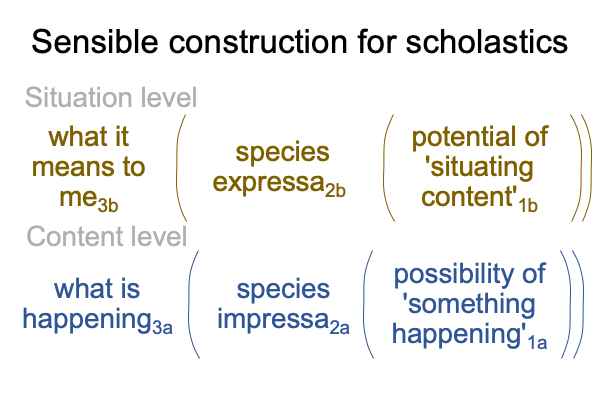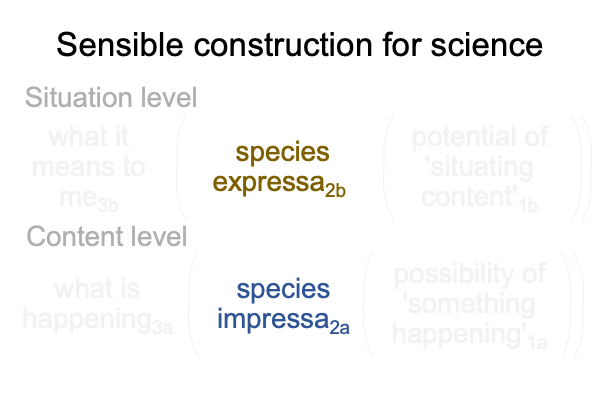0033 Where does this notion of specificative extrinsic formal causality come from?
Comments on John Deely’s Book (1994) New Beginnings is a good place to start.
The specifying sign is embedded in a formula for sensible construction, arrived at by Latin schoolmen during the later Middle Ages.
Obviously, the scholastics did not know that. The discovery of the triadic nature of the sign-relation comes towards the end of centuries of philosophical inquiry and debate (say nothing of political intrigue), during a period labeled, “Baroque scholasticism”. Baroque scholars witness the end of the Latin Age at the same time that mechanical philosophers usher in the beginning of the Age of Ideas (that is, the modern period). This terminology comes from John Deely (1942-2017 AD) and appears in his massive tome, The Four Ages (2001). The four ages are the Greek Age, the Latin Age, the Age of Ideasand the forthcoming Age of Triadic Relations.
0034 The category-based nested form comes in handy when portraying sensible construction. Here is a picture for how humans think.

0035 There are several items to note.
First, the actualities are Latin terms. “Species” (say it with an Italian accent, with lots of cheese) means “type of”. “Impressa” means impression or sensation or feeling. “Expressa” means perception or phantasm or emotional reaction.
Second, the situation level emerges from (and virtually situates) the content level. The vertical elements are nested. Species expressa2b virtually situates species impressa1a. The qualifier, “virtual”, means “in virtue”, for the mind, and “in simulation”, for the brain.
Third, Aristotle’s four causes allow me to appreciate normal context3 and potential1. The four causes allow me to comprehend an actuality2. Material, instrumental, final and formal causes elucidate a category-based form that incorporates the actuality at hand.
0036 Say what?
At the start of chapter three in Dennett’s book, titled “On the Origins of Reasons”, the author lists Aristotle’s four causes. Two of the four causes are familiar to scientists. These are the material and efficient (or instrumental) causes. The other two causes are ruled out by the positivist intellect. These are formal and final causes. Today, formal and final causalities are not regarded as “scientific” at all.
0037 What does this imply?
Without all of Aristotle’s four causes, only actualities are relevant. The normal contexts and potentials cannot be considered, much less appreciated. A species impressa2a and a species expressa2b constitute a manifest image of sensible construction. The following figure is the corresponding scientific image.

0038 Well, there goes the whole discussion on how Darwin’s paradigm and the specifying sign may be analogies of one another.
Indeed, there goes the specifying sign, along with comprehension.
0039 The scientific picture only allows for material and instrumental causation.
Yet, we cannot comprehend any actuality without final and formal causation.
What can we do if we cannot comprehend?
We can assess competence.
0040 We can measure phenomena of perceptions in response to particular sensations.
How does a human brain come to recognize that the dog is happy because it wags its tail?
Can I fashion a mechanical or mathematical model, using a disciplinary language, describing neurons selecting for synapses which either exploit or avoid an affordance?
How does one build a model on observations and measurements of species impressa1b and species expressa2b?
One scientific model would be like a giant betting parlor filled with neocortical neurons, where each successful bet raises the stakes. A perception, a species expressa2b, is like a winner2b, in this regard. A phantasm2b depends on the survival and demise of synapses, so the qualia of the species impressa2a (those impressions, sensations and feelings) constitute the “winnings’ that perception2b rakes in (and must use to bet again).
0041 In many respects, the survival and demise of synapses1b corresponds to what psychologists might call “priming” or “training”. Neurons perform natural selection3b on synapses2b. The result is not comprehension. The result is competence.
My brain’s reading of my dog’s attitude2b, my species expressa2b, turns into an example of competence, stimulated by observations of my dog’s tail2a. My brain is competent at conjuring a phantasm2b that seems, upon subsequent reflection, to be perfectly sensible.
0042 My brain’s competence even extends to Daisy’s reaction to the neighbor’s cat.
Here is a diagram.

0043 At this juncture, I feel that I am on the verge of slipping from my brain to my mind.
Oh, I meant to say, “the user-illusion of my brain”.
0044 The first aspect of the slippage goes with chapter eight, titled “Brains Made of Brains”, more or less applying the Darwinian paradigm as a metaphor for the specifying sign. Neurons3b selectively breed synapses1b in order to participate in adaptive neural networks2b.
0046 The second part of the slippage starts with chapter three, titled “The Origin of Reason”, and concerns the fact that, on the occasion of my reactionary dog encountering the neighbor’s revolutionary cat, the process of natural selection3b of neural synapses3b, provides me with a phantasm2b, a manifest image2b, a species expressa2b, that avoids the affordance1bimplied by my dog’s tail action2a. I pull Daisy back on her leash in order to prevent her from engaging in an impetuous action.
Yes, my brain provides its user with an illusion. The phantasm2b that occupies my mind is a solution to a challenge similar to the Turing test. The Turning test asks a question, “Can a human observer distinguish whether an action or behavior is in virtue or in simulation?” If the answer is no, then the action passes the test. My phantasm2b is a human thought that passes Turing’s test. It has the virtue of being human. But, that does not mean that I created my phantasm.
0047 No, a specific application of the Darwinian paradigm “designed” my phantasm2b.
I do not comprehend how I obtain the phantasm2b in my mind, because it has been designed without a designer. It has been conjured by an evolutionary process.
Even more, the phantasm in my mind swarms with formal and final causalities, which cannot be recognized by a positivist intellect, er, I mean to say… a scientist.
The positivist intellect has a rule.
Metaphysics is not permitted.
